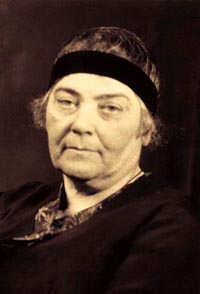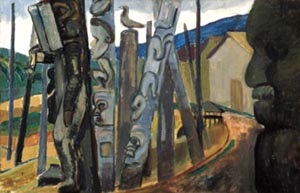Emily
Carr
Searching for Primal Energies (1871-1945)
Emily Carr once wrote, “I could
not paint in the old way - it is dead - meaningless - empty.” Because of
these strong views, she was ostracized for years by her family and the
people of British Columbia. Now, 50 years after her death, she is recognized
as one of Canada’s greatest painters - male or female - and numerous books,
besides her own autobiography, have been written about her work and about
her personal life-style that differed greatly from expectations for a woman
in Victorian times.
Born in 1871 in Victoria, British
Columbia, Emily had four older sisters and a younger brother. She was 12
when her mother died and, on the death of her domineering father two years
later, her eldest sister ruled in similar fashion, even, on occasion, whipping
her rebellious youngest sister.

|
Following her 1910 visit to France,
an invigorated Emily Carr returned to British Columbia, bringing with her
a postimpressionist style that marked the end of her earlier anachronistic
English water colour mode. By 1932, after encouragements from the likes
of Lawren Harris and still other Group of Seven members, Emily Carr's canvases
began stressing themes of nature rather than recording the vanishing villages,
houses and totem poles of First Nation Peoples of the northwest, themes
which earlier had predominated her canvases for 20 years. [Photo, courtesy
The Art Gallery of Ontario] |
To escape such tyranny, Emily
rode her pony to nearby Beacon Hill Park where she first sensed the joy
of the forest. Like many young women of the era, she took art lessons and,
while still in her teens, enrolled at the California School of Design in
San Francisco. There she painted the basics: antiques, still life, and
scenery, but was too shy to take the “life” class that posed nude females.
In 1893 she returned to Vancouver
and opened a studio in the loft of the cow barn on the family property.
She happily taught children and painted, spending the summer of 1898 at
Ucluelet, an Indian village on the northwest coast of the island where
she met the native peoples and experienced their day-to-day culture. Because
she could not speak their language, she resorted to pantomime. The ensuing
laughter caused them to call her “Klee Wyck” or Laughing One.
Emily, realizing that she needed
more training, enrolled the following year at the Westminster School of
Art in London, England. She did not enjoy the city and found the countryside
too manicured, but she studied and worked hard for four years until illness
forced her into a sanitarium for 18 months.
 |
Fascinated by nature's
pulsating energy, Emily Carr's later career examines the mysterious, undulating
vibrations of nature as portrayed in "Sombreness Sunlit," circa 1937-40.
[Photo, courtesy The Province of British Columbia Archives] |
Back in Canada in 1905, she
opened a studio in Vancouver – again gave art lessons and spent summers
with the native people, often sleeping “in tents, in roadmaker’s tool sheds,
in missions, and Indian houses.” Her friendship with the native people
gave her new insights into their creativity, but again she felt more training
was needed and, in 1910, went to Paris to study at the Académie
Colarossi.
Once more, however, Emily became
ill and spent “three hellish months” in hospital. A doctor advised her
to stay out of large cities and, since Harry Gibb, her teacher, held “new
school” classes at Crécy – a two-hour trip from Paris – she went
there. Gibb was supportive, once predicting, “You will one day be one of
the women painters of your day.” Before she left to return to Vancouver
in 1911, two of her paintings were shown at a Paris salon.
On her return, Emily refused
to paint the fashionable pretty scenery then in vogue but, instead, created
sweeping scenes with bold and vivid colours. These embarrassed her sisters
and caused the public to laugh at her work. The art school did not rehire
her and parents stopped sending their children for private lessons. Despite
this, she carried on and, in the summer of 1912, travelling with only a
sheepdog for a companion, sketched and painted other remote villages on
the Queen Charlotte Islands and Skeena River.
With no money coming in, Emily
was forced to return to Victoria where the family property was divided
among the sisters (her sickly brother had died). With her share, Emily,
now over 40, decided to build and run a boarding house.
For the next 15 years she cooked,
cleaned, and did most of the repair work. To earn extra money, she also
raised and sold sheepdogs, hooked rugs, and created pottery based on native
designs to sell to tourists while most of her paintings remained in the
attic. Her eccentricities were a source of amusement for she surrounded
herself with pets – dogs, birds that included a parrot and a cockatoo,
a white rat, and a monkey named Woo that she often wheeled about in a baby
carriage.

|
From an earlier period in the career
of Emily Carr, "Indian Village with Totem Poles," oil on canvas, documents
her passion to record the vanishing visual history of British Columbia's
westcoast First Nation Peoples. [Photo, courtesy The Collection of Power
Corporation of Canada] |
In 1927, however, her life
changed dramatically. In 1926, Ottawa’s National Gallery decided to exhibit
“Canadian West Coast Art, Native and Modern,” and asked Marius Barbeau,
an anthropologist, to help find exhibits. Barbeau, who had learned of Emily
through the Indians, visited her and recommended her work to Eric Brown,
the gallery’s director. He, too, visited her, was impressed with the power
and originality of her work, and asked her to send 50 paintings as well
as some of her rugs and pottery to Ottawa. He also arranged a rail pass
for her to see the show and suggested she read a book about a Toronto-based
group of artists known as the Group of Seven.
She had never heard of them
but obtained Fred Housser’s A Canadian Art Movement and, before
heading east, visited Frederick Varley, then teaching in Vancouver. He
wired his colleagues and she met A.Y. Jackson, Arthur Lismer, J.E.H. MacDonald,
and, finally, Lawren Harris, whose work so excited her that after the opening
of the Ottawa show – at which 26 of her paintings were exhibited and praised
– she returned to Toronto to revisit Harris who became one of her staunchest
supporters.
On her return to Victoria she
immediately resumed painting. Within weeks she was encouraged when Harris,
after seeing her work in Toronto, wrote, “I really have, nor can have,
nothing to say by way of criticism.... The pictures are works of art in
their own right.”
Emily worked with renewed energy
and skill, repainting many of her previous pieces and revisiting some of
the Indian villages to paint them afresh. She was invited to exhibit paintings
in a Group of Seven show where further praise was lavished on the improvement
and greater freedom of her work. “I am astonished,” A.Y. Jackson wrote.
Harris went further and, by suggesting she broaden her scope “to create
forms for yourself, direct from nature,” he thereby stimulated her to paint
the forests and vast scenery of British Columbia with greater verve and
creativity.
Over the next decade her work
was exhibited in numerous shows in Victoria, Vancouver, Eastern Canada,
the USA, and at a Commonwealth exhibit at the Tate Gallery in London where
the Times critic considered her Indian Church “one of the
most interesting pictures in the exhibit.”
By then she had sold the boarding
house and moved into a cottage, where she suffered her first heart attack
in 1937. When her doctor insisted she live more quietly, she turned to
writing stories about Indians she had visited over the years. Her first
book she called Klee Wyck. When a publisher rejected it, she put
it aside until a friend, a previous student boarder who had become a math
professor, showed it to Garnett Sedgewick, professor of English at the
University of British Columbia. He read some of the stories to his classes
and to a wider audience over CBC Radio.
Ira Dilworth, then head of
CBC’s Western region, also read her stories over the air and sent Klee
Wyck to Clarke, Irwin & Company in Toronto where it was soon published
and became an instant success. Suddenly Victoria was proud of her. A local
woman’s club celebrated her 70th birthday in December 1941 with a huge
tea party with messages from various dignitaries. Klee Wyck also
won the Governor General’s Award for Literature for that year. She made
light of the newfound success but enjoyed it.
Like Harris, Dilworth also
became one of her trusted friends and supporters. He edited her subsequent
books: The Book of Small (1942) about her childhood published a
year after Klee Wyck; and The House of All Sorts (1944) about
her boardinghouse experiences. After her death, there were four more volumes
including Growing Pains, an autobiography she had started at Lawren
Harris’ suggestion.
Before she died in March 1945
– after several heart attacks and two strokes – she created an Emily Carr
Trust – naming Harris and Dilworth to select 45 of her paintings
for the Vancouver Art Gallery. The rest of her work was to be sold as needed
for the upkeep of the Trust. Any leftover money was to be used for the
education of Canadian artists. The Trust remained in effect until 1969.
The Vancouver Art Gallery now exhibits in a special room almost 200 pieces
of her work. Many thousands of residents and tourists visit annually to
admire – not laugh at – her remarkable talent as an artist.
Mel James


